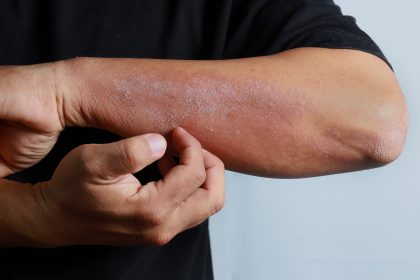Psoriatic arthritis is a chronic inflammatory condition that can significantly impact the quality of life of those affected. Understanding where and how this disease manifests in the body can help in managing its symptoms more effectively. In this article, we’ll explore the five key areas where psoriatic arthritis typically shows up, providing insights into its symptoms and potential treatment options.
1. Joints of the hands and feet
Psoriatic arthritis commonly affects the small joints in the hands and feet. This can lead to swelling, pain and stiffness, making everyday tasks challenging.
Symptoms and impact
- Dactylitis: Also known as “sausage digits,” dactylitis causes severe swelling of the fingers and toes, making them look like sausages.
- Nail changes: Many individuals experience pitting, ridges and separation of the nail from the nail bed, which is often an early sign of psoriatic arthritis.
Management
- Medications: Nonsteroidal anti-inflammatory drugs (NSAIDs) and disease-modifying antirheumatic drugs (DMARDs) can help reduce inflammation and pain.
- Physical therapy: Exercises tailored to improve hand and foot function can be beneficial.
2. Spine (axial psoriatic arthritis)
When psoriatic arthritis affects the spine, it is referred to as axial psoriatic arthritis. This form can cause pain and stiffness in the neck, lower back and pelvic region.
Symptoms and impact
- Back pain: Persistent pain in the lower back and neck that worsens with rest and improves with movement.
- Stiffness: Morning stiffness lasting more than 30 minutes is a common complaint.
Management
- Biologic treatments: Biologic drugs that target specific parts of the immune system can be particularly effective for spinal inflammation.
- Exercise: Regular stretching and strengthening exercises can help maintain mobility and reduce stiffness.
3. Knees
The knees are another common site for psoriatic arthritis to manifest. The condition can lead to swelling, pain and decreased range of motion in this crucial weight-bearing joint.
Symptoms and impact
- Swelling: Accumulation of fluid in the knee joint, causing it to swell and feel warm to the touch.
- Pain: Persistent knee pain that may worsen after periods of inactivity or excessive use.
Management
- Injections: Corticosteroid injections can provide relief from severe knee inflammation.
- Weight management: Maintaining a healthy weight can reduce the stress on the knee joints.
4. Ankles
Ankle involvement in psoriatic arthritis can cause significant discomfort and mobility issues. The inflammation in the ankle joints can make walking and standing difficult.
Symptoms and impact
- Swelling and tenderness: The ankles may become swollen and tender, making it hard to wear certain types of footwear.
- Reduced mobility: Stiffness and pain can limit the range of motion, impacting daily activities.
Management
- Supportive footwear: Wearing shoes that provide good support and cushioning can help alleviate pain.
- Orthotic devices: Custom-made orthotic inserts can provide additional support and relieve pressure on the ankles.
5. Elbows
Elbow involvement can lead to discomfort and difficulty in performing tasks that require arm movement. Psoriatic arthritis can cause both the joint and the surrounding tendons to become inflamed.
Symptoms and impact
- Pain and swelling: The elbows may become painful and swollen, making it hard to extend or flex the arm.
- Tendonitis: Inflammation of the tendons around the elbow, such as tennis elbow or golfer’s elbow, is common.
Management
- Topical treatments: Applying medicated creams and ointments can help reduce localized inflammation.
- Physical therapy: Specific exercises can strengthen the muscles around the elbow and improve flexibility.
Managing psoriatic arthritis
Psoriatic arthritis is a multifaceted disease that can affect various parts of the body, leading to a range of symptoms and challenges. By understanding where and how it manifests, individuals can seek appropriate treatments and lifestyle modifications to manage their condition effectively. Whether it’s through medication, physical therapy or supportive devices, addressing the specific areas affected by psoriatic arthritis can significantly improve the quality of life for those living with this chronic condition. If you suspect you have psoriatic arthritis, consulting with a health care professional is crucial for a proper diagnosis and treatment plan.











